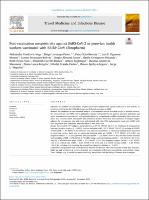| dc.contributor.author | Cvetkovic Vega, Aleksandar | |
| dc.contributor.author | Urrunaga Pastor, Diego | |
| dc.contributor.author | Soto Becerra, Percy | |
| dc.contributor.author | Figueroa Montes, Luis E. | |
| dc.contributor.author | Fernandez Bolivar, Lizette | |
| dc.contributor.author | Alvizuri Pastor, Sergio | |
| dc.contributor.author | Oyanguren Miranda, Martin | |
| dc.contributor.author | Neyra Vera, Ibeth | |
| dc.contributor.author | Carrillo Ramos, Elizabeth | |
| dc.contributor.author | Sagástegui, Arturo | |
| dc.contributor.author | Contreras Macazana, Roxana | |
| dc.contributor.author | Lecca Rengifo, Diana | |
| dc.contributor.author | Grande Castro, Nikolai | |
| dc.contributor.author | Apolaya Segura, Moises | |
| dc.contributor.author | Maguina, Jorge L. | |
| dc.date.accessioned | 2023-03-17T22:09:46Z | |
| dc.date.available | 2023-03-17T22:09:46Z | |
| dc.date.issued | 2023-04 | |
| dc.identifier.citation | Travel Medicine and Infectious Disease. 2023;52. | es_PE |
| dc.identifier.issn | 1477-8939 | |
| dc.identifier.uri | https://hdl.handle.net/20.500.12959/3475 | |
| dc.description.abstract | Objective: To estimate the prevalence of post-vaccination seropositivity against SARS-CoV-2 and identify its predictors in Peruvian Social Health Insurance (EsSalud) personnel in 2021.
Methods: We conducted a cross-sectional study in a representative simple stratified sample of EsSalud workers. We evaluated IgG anti-SARS-CoV-2 antibodies response (seropositivity) by passive (previous infection) and active immunization (vaccination), and epidemiological and occupational variables obtained by direct interview and a data collection form. Descriptive and inferential statistics were used with correction of sample weights adjusted for non-response rate, and crude and adjusted odds ratio (OR) and geometric mean ratio (GMR) with their respective 95% confidence intervals (95%CI) were estimated.
Results: We enrolled 1077 subjects. Seropositivity was 67.4% (95%CI: 63.4–71.1). Predictors of seropositivity were age (negative relation; p < 0.001), previous infection (aOR = 11.7; 95%CI: 7.81–17.5), working in COVID-19 area (aOR = 1.47; 95%CI: 1.02–2.11) and time since the second dose. In relation to antibody levels measured by geometric means, there was an association between male sex (aGMR = 0.77; 95%CI: 0.74–0.80), age (negative relation; p < 0.001), previous infection (aGMR = 13.1; 95%CI:4.99–34.40), non-face-to-face/licensed work modality (aGMR = 0.78; 95%CI: 0.73–0.84), being a nursing technician (aGMR = 1.30; 95%CI: 1.20–1.41), working in administrative areas (aGMR = 1.17; 95%CI: 1.10–1.25), diagnostic support (aGMR = 1.07; 95%CI: 1.01–1.15), critical care (aGMR = 0.85; 95%CI: 0.79–0.93), and in a COVID-19 area (aGMR = 1.30; 95%CI: 1.24–1.36) and time since receiving the second dose (negative relation; p < 0.001).
Conclusions: Seropositivity and antibody levels decrease as the time since receiving the second dose increases. Older age and no history of previous infection were associated with lower seropositivity and antibody values. These findings may be useful for sentinel antibody surveillance and the design of booster dose strategies. | es_PE |
| dc.format | application/pdf | es_PE |
| dc.language.iso | eng | es_PE |
| dc.publisher | Royal College of Physicians and Surgeons de Glasgow | es_PE |
| dc.relation.uri | https://www.sciencedirect.com/science/article/pii/S1477893922002605 | es_PE |
| dc.rights | info:eu-repo/semantics/openAccess | es_PE |
| dc.rights.uri | https://creativecommons.org/licenses/by-nc-sa/4.0/ | es_PE |
| dc.subject | Covid-19 | es_PE |
| dc.subject | Vaccine | es_PE |
| dc.subject | Serology | es_PE |
| dc.subject | Antibodies | es_PE |
| dc.subject | Doses | es_PE |
| dc.subject | Vacunas | es_PE |
| dc.subject | Serología | es_PE |
| dc.subject | Anticuerpos antivirales | es_PE |
| dc.subject | Infecciones por coronavirus | es_PE |
| dc.title | Post-vaccination seropositivity against SARS-CoV-2 in peruvian health workers vaccinated with BBIBP-CorV (Sinopharm) | es_PE |
| dc.type | info:eu-repo/semantics/article | es_PE |
| dc.subject.ocde | https://purl.org/pe-repo/ocde/ford#3.03.08 | es_PE |
| dc.subject.ocde | https://purl.org/pe-repo/ocde/ford#3.03.09 | es_PE |
| dc.identifier.doi | https://doi.org/10.1016/j.tmaid.2022.102514 | |






